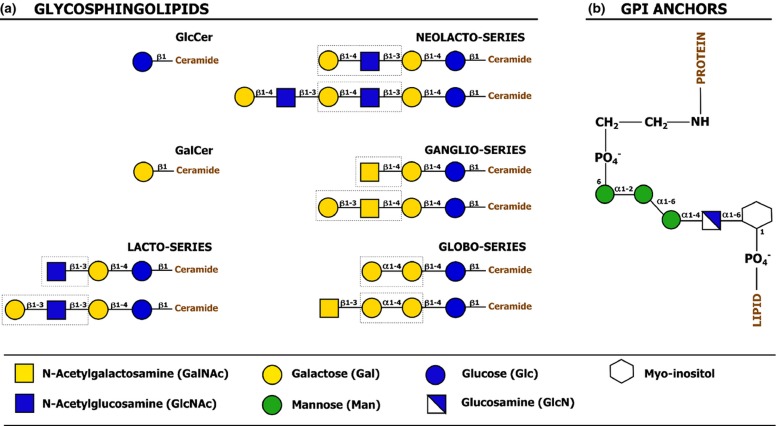Figure 2.
Classification and basic structure of major types of lipid-linked glycosylation. (a) Glycosphingolipids consist of a hydrophilic glycan moiety linked to a hydrophobic sphingolipid. In higher animals, a ceramide lipid molecule is initially modified with a β-linked glucose or galactose residue, after which further extension and modification of the glycan moiety can occur. Extension to larger glycan chains is common on ceramide-linked glucose residues, whereas further glycan extension on ceramide-linked galactose residues is more rare. Depending on their glycan core structure, glycosphingolipids are classified in ‘series’. The figure depicts a number of glycosphingolipid core structures. The key features that characterize each series are shown in dashed boxes. Core structures can be further modified with sialic acids or sulfate groups, which allows subclassification of glycosphingolipids as neutral (lacking charged carbohydrates or ionic groups), sialylated or sulfated. (b) Glycosylphosphatidylinositol (GPI) anchors are found in association with certain membrane proteins and serve as linkers between the protein and the lipid membrane. Glycosylphosphatidylinositol anchors have a common core structure comprising ethanolamine-PO4-6Manα1-2Manα1-6Manα1-4GlcNα1-6myo-inositol-1-PO4-lipid. Differential derivatization of this common core structure through lipid remodeling and modification of the glycan moiety can cause significant glycosylphosphatidylinositol anchor heterogeneity. The protein is linked to the glycosylphosphatidylinositol anchor via an amide linkage between the C-terminal carboxyl group of the protein and the amino group of phosphatidylethanolamine (adapted from Varki et al., 2009).

